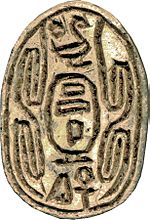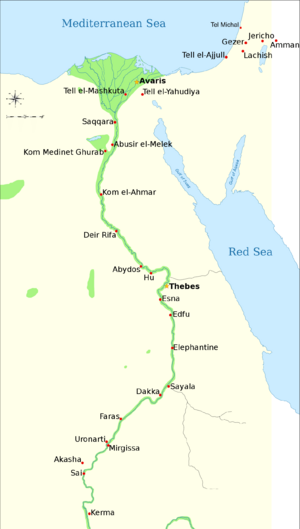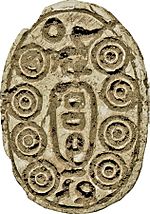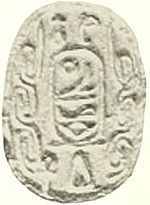Sheshi facts for kids
Quick facts for kids Maaibre Sheshi |
|
|---|---|
| Sheshy, Shesha, Mayebre | |

Scarab seal inscribed with
"the son of Ra, Sheshi, given life" |
|
| Pharaoh | |
| Reign | duration highly uncertain: three years, 19 years, c. 40 years. (14th dynasty or 15th dynasty) |
| Coregency | Conjectural coregency with Nehesy (Ryholt) |
| Predecessor | uncertain, Ammu Aahotepre |
| Successor | uncertain, Nehesy Aasehre, Yaqub-Har |
| Consort | uncertain, Tati (Ryholt) |
| Children | uncertain, Nehesy ♂, Ipqu ♂ (Ryholt) |
Maaibre Sheshi (also known as Sheshy) was an ancient Egyptian ruler during a time called the Second Intermediate Period. This was a confusing time in Egypt's history. Experts are still debating when exactly he ruled, how long he was in power, and how much land he controlled. It's hard to figure out what happened from the end of the Middle Kingdom until the Hyksos people arrived in Egypt. Even so, Sheshi is the most well-known king from this period, thanks to the many items found with his name. These items date from around 1800 BC to 1550 BC. Hundreds of small, carved objects called scarab seals with his name have been discovered. They have been found all over Canaan, Egypt, and Nubia. Some even made it as far as Carthage, where they were still used 1,500 years after Sheshi's death!
Contents
Who Was Pharaoh Sheshi?
Historians and archaeologists have different ideas about which group of rulers Sheshi belonged to.
- Some experts, like Nicolas Grimal and William C. Hayes, think Sheshi was Salitis. Salitis was the first king of the 15th Dynasty, which was made up of the Hyksos people who came to Egypt. They believe Salitis ruled for 19 years, sometime between 1720 BC and 1650 BC.
- Other experts, like William Ayres Ward, suggest Sheshi was a Hyksos king who ruled later in the 15th Dynasty, between kings Khyan and Apophis.
- Another idea, from Manfred Bietak, is that Sheshi was a ruler who served the Hyksos, controlling a part of Egypt or Canaan. However, some experts aren't sure if such rulers even existed.
- Finally, some, like Kim Ryholt, believe Sheshi was an early king of the 14th Dynasty. This was a group of kings from Canaan who ruled the eastern Nile Delta just before the Hyksos arrived. They think Sheshi ruled for about 40 years, starting around 1745 BC.
Ryholt also suggested that Sheshi made an alliance with the Kushites in Nubia. He thinks Sheshi did this by marrying a Nubian princess named Tati. Ryholt believes their son was Nehesy, whose name means "The Nubian." He thinks Nehesy then became pharaoh after Sheshi.
How Do We Know About Him?
Seals and Names
Sheshi's name, or nomen, is carved on more than 200 scarab seals. These seals are the only real proof we have of his rule. The number of scarabs with Sheshi's name is only matched by those with the name Maaibre. This name, called a prenomen, means "The righteous one is the heart of Ra." Because these two groups of scarabs look very similar and are found in such large numbers, most experts agree that Maaibre was Sheshi's royal name.
This means Maaibre Sheshi is the best-known ruler of the Second Intermediate Period. We have 396 seals and two seal impressions with his names. This is three times more than the 123 seals found for the next most common king of that time, Yakbim Sekhaenre.
Some experts, like Manfred Bietak, also think a scarab found in Avaris with the name "Shenshek" might belong to Sheshi. But others, like Kim Ryholt, believe Shenshek was a different king.
Finding Spots
Most of the seals linked to Maaibre Sheshi (over 80%) were found without knowing their exact origin. However, the other 20% were discovered all over Egypt, Nubia, and Canaan. This shows that there was a lot of trade and communication during Sheshi's time.
Important places where seals were found include Lachish, Gezer, Jericho, Tel Michal, Amman, and Tell el-Ajjul in Canaan. In northern Egypt, three seals were found in Tell el-Yahudiya and Tell el-Mashkuta. Eight more came from the wider Delta area. Four seals were found in Saqqara, and five more in central Egypt. In southern Egypt, twenty seals were found in places like Abydos, Hu, Thebes, and Elephantine.
In Nubia, Sheshi's seals were found in Egyptian forts like Uronarti and Mirgissa. They were also found in other Nubian sites such as Dakka, Kerma, and Aniba.
Interestingly, two seal impressions of Sheshi were found in Carthage. These were found in an area that dates back to the 2nd century BC, which is 1,500 years after Sheshi lived!
Today, Sheshi's seals are kept in many museums around the world. These include the Israel Museum, the Petrie Museum, the British Museum, and the Egyptian Museum of Cairo.
Old Records
We don't have any clear historical records that mention Sheshi. His name is not on the Turin canon. This is a list of kings written on papyrus much later, during the Ramesside period. This list is our main source for the Second Intermediate Period. However, the part of the papyrus that covers Sheshi's time is badly damaged. So, we can't use it to figure out when he ruled.
It's also not clear if Sheshi is mentioned in the Aegyptiaca. This was a history of Egypt written by an Egyptian priest named Manetho around 300 BC. The Aegyptiaca only uses Greek versions of Egyptian pharaohs' names. So, it's hard to match Sheshi to any of those names.
Some experts, like Aharon Kempinski and Donald B. Redford, have suggested that Sheshi might be the real person behind the Biblical character Sheshai. Sheshai was one of the Anakim living in Hebron when the Hebrews conquered Canaan, as mentioned in the Bible.
Different Ideas About Sheshi
There are three main ideas about which group of kings Sheshi belonged to.
Hyksos Ruler?

Some experts, including William C. Hayes and Nicolas Grimal, think Sheshi was Salitis. Salitis was the founder of the Hyksos 15th Dynasty. However, others believe Salitis was actually Sakir-Har, another ruler who was known to use the title "Hyksos."
If Sheshi was Salitis, then the seals found in Nubia suggest that the Hyksos made friends with the Nubians. They might have done this to fight against the native Egyptian 13th Dynasty when they arrived in the Nile Delta around 1720 BC. Grimal thinks Sheshi's kingdom would have covered the entire Nile Delta and the Nile valley north of Gebelein. According to ancient writings, Salitis ruled from Memphis. He also strengthened the city of Avaris, which became the Hyksos' main city.
Some experts also connect Sheshi with a king named Sharek. Sharek is only mentioned on one stone slab that lists the family tree of a priest who lived much later, around 750 BC.
More recently, experts like William Ayres Ward have looked at the style of Sheshi's seals. They believe Sheshi ruled in the second half of the 15th Dynasty, between the powerful Hyksos pharaohs Khyan and Apophis.
Hyksos' Helper?
Jürgen von Beckerath suggests that Sheshi might have been a "vassal" of the Hyksos. This means he would have been a smaller ruler who served the main Hyksos kings. Von Beckerath groups Sheshi with other Hyksos rulers whose exact time of rule is uncertain. He also includes kings he believes were helpers of the Hyksos. This idea is based on the thought that Manetho's 16th Dynasty included minor rulers in the Nile Delta who served the powerful 15th Dynasty Hyksos kings.
Manfred Bietak thinks that because so many items of Sheshi have been found, he must have been an important Hyksos ruler. But since there are no large monuments built by him, Bietak wonders if Sheshi was part of the 15th Dynasty. Instead, Bietak suggests Sheshi was one of the West Semitic rulers who lived at the same time as the 15th Dynasty. They might have been helpers or partly independent from the Hyksos.
The idea of these "lesser Hyksos" kings in Egypt is still debated. Some experts argue that Manetho's original text didn't say the Hyksos had vassals. They believe the 16th Dynasty was actually a native Egyptian dynasty that ruled the Theban region independently. However, other experts, like Redford and Bietak, still believe that the Hyksos did have smaller rulers under them in places like Palestine and Middle Egypt.
King of the 14th Dynasty?
Kim Ryholt and Darrell Baker disagree that Sheshi was a 15th Dynasty Hyksos ruler. Ryholt points out that early Hyksos kings, like Sakir-Har and Khyan, used the title Heqa khasewet, meaning "ruler of the foreign lands." Sheshi did not use this title. Also, later Hyksos kings only started using an Egyptian royal name (prenomen) during the second half of their rule. But if Sheshi is Maaibre, he used a prenomen from the start. This suggests he was either a Hyksos king ruling after Khyan (which doesn't fit the known list of kings) or he belonged to a different group of rulers.
Because of this, Ryholt suggests Sheshi was a king of the 14th Dynasty. This was a group of kings from Canaan who probably ruled the Eastern Nile Delta just before the Hyksos 15th Dynasty arrived. Many experts agree that the 14th Dynasty existed. This is based on archaeological finds and the fact that about 50 kings are listed in the Turin canon between the 13th Dynasty and the later Hyksos rulers. However, Redford thinks these 50 kings were actually the family line of the Hyksos rulers, and that the 14th Dynasty never existed.
Based on how scarab seals changed over time, George Willoughby Fraser in 1900 thought Sheshi ruled in a "short dynasty before the Hyksos invasion." More recently, Ryholt came to a similar conclusion. He places Sheshi before kings like Yaqub-Har and the great Hyksos rulers Khyan and Apophis. Ryholt believes Sheshi came after kings like Yakbim Sekhaenre and 'Ammu Ahotepre.
When Did Sheshi Rule?
Early Dates
Ryholt believes Sheshi ruled around the mid-18th century BC. His main reason is that seals of Sheshi and two kings from the mid-13th Dynasty were found together. These were found in an Egyptian fort in Nubia called Uronarti. This fort was abandoned during the 13th Dynasty. Ryholt thinks this happened during the rule of King Djedkheperew, because no seals from later kings were found there. So, Ryholt suggests Sheshi ruled from about 1745 BC to 1705 BC, at the same time as these 13th Dynasty kings.
Ryholt's idea about Sheshi means he thinks the 14th Dynasty started around 1805 BC. This is about 90 years earlier than most experts believe. Most Egyptologists think the 14th Dynasty began during the rule of King Merneferre Ay, between 1700 BC and 1660 BC. Ay was the last 13th Dynasty pharaoh known to have ruled in northern Egypt. Many experts believe he left the capital city of Itjtawy and moved to Thebes. This was because he lost control of the Nile Delta region to the 14th Dynasty.
Later Dates
If Sheshi was Salitis, the founder of the 15th Dynasty, then he would have lived around 1650 BC. This is the date most experts agree on for when the Hyksos arrived in Egypt. If Sheshi ruled later in the 15th Dynasty, between Khyan and Apophis, as Ben-Tor and Ward suggest, then he would have reigned around 1600 BC.
How Long Did He Rule?
Experts who think Sheshi was Salitis believe he ruled for 19 years. This number comes from ancient writings about Manetho's history. Ryholt uses a different method. He estimates Sheshi's rule lasted between 20 and 53 years, suggesting about 40 years. He does this by comparing the number of Sheshi's seals to those of other kings who ruled for known periods. Since Sheshi has nearly 400 scarabs, this would mean a longer reign.
Sheshi's Family Life
Ryholt suggests that Sheshi had at least two wives. One was Queen Tati, with whom he had his son and successor, Pharaoh Nehesy. He also thinks Sheshi had another queen who was the mother of Prince Ipqu. Ryholt came to this idea because the scarabs of Queen Tati and Princes Ipqu and Nehesy look similar to Sheshi's seals. This suggests they lived at the same time. Also, "Tati" was a Nubian name, which would explain why Nehesy's name means "the Nubian." Ryholt believes Sheshi married a Kushite princess to form an alliance with the Nubians.
Ryholt's idea about Nehesy might be supported by some scarabs that call Nehesy "king's son" and "eldest king's son." This would mean Nehesy's father was also a king. Also, both Nehesy and Ipqu used the title "king's son of Ra." This might mean Sheshi made them junior co-rulers.
Darrell Baker agrees with these ideas, but Daphna Ben-Tor does not. She thinks Nehesy ruled before Sheshi. She also believes the "king's son Nehesy" was a later Hyksos prince. In 2005, a stone slab of Nehesy was found in the city of Tjaru. This slab shows a "king's son Nehesy" offering oil to a god. It also mentions a "king's sister Tany." A woman with this name and title is known from other sources around the time of the Hyksos pharaoh Apophis, about 1570 BC. This suggests that the "king's son Nehesy" on the slab lived around 1570 BC, which is over 100 years after King Nehesy's estimated time. Ben-Tor also notes that the scarabs referring to the "king's son Nehesy" look different from those referring to King Nehesy. This would mean they were two different people.
Images for kids
-
Scarab seal inscribed with
"the son of Ra, Sheshi, given life" -
Seal reading "the Son of Ra, Sheshi, living for ever", Walters Art Museum
See also
 In Spanish: Xexi para niños
In Spanish: Xexi para niños









